Operation
Here is how the ZEV standard operates.
Credit target
Automakers subject to the standard must accumulate credits by supplying the Québec market with zero-emission vehicles (ZEVs) or low-emission vehicles (LEVs). The number of credits required is calculated by applying a percentage to the total number of light-duty vehicles that each automaker sells in Québec. The credit requirement thus varies from one automaker to another.
Granting of credits
Model years 2018–2024
During the first years in which the ZEV standard applies, each sale or lease of a ZEV recognized by the Minister earns credits for the automaker. The number of credits varies depending on the vehicle’s electric range. The greater the range a vehicle has, the greater the number of credits the automaker earns, which reduces the number of ZEVs that it must sell to meet its credit target.
The purpose of the ZEV standard is thus to incentivize the automobile market to develop greater numbers of models that rely on increasingly efficient low-carbon technologies.
Model year 2025 and subsequent years
With the strengthening of the ZEV standard enacted by the government in 2023, credits will be granted differently for model year 2025 and subsequent years. Each sale or lease of a ZEV recognized by the Minister earns the manufacturer one (1) credit. Each LEV sale with an electric range of over 80 kilometres earns half a credit (0.5). Note that the government has allowed for some flexibility for the years 2025, 2026 and 2027. As such, LEVs with an electric range of 50 to 80 kilometres will earn part of the half-credit, based on the calculation provided for in the regulations.
- Use of credits
Small automakers not subject to the law and the best-performing automakers can also derive financial gain from the sale of their excess credits to other automakers that may choose to purchase them, for example to avoid paying charges prescribed by the regulation, or keep them to meet their future needs.
Moreover, automakers can use the credits accumulated in previous compliance periods to ensure compliance in current and future periods. However, the government is empowered to oversee the use of the credits carried over to attain its objectives. During the 2019–2021 compliance period, automakers were entitled to use previously accumulated credits to satisfy a maximum of 35% of their requirements. For the period 2022–2024, they are entitled to use previously accumulated credits to satisfy up to 25% of their requirements. These ceilings will gradually decrease until they reach 0% in 2034 in order to ensure that 100% of new light-duty vehicles sold in 2035 are electric, regardless of previous ZEV credits. In phase 2, for model year 2025 and subsequent years, credits will have an expiry date, meaning that it will only be possible to use them during the period in which they were accumulated and the period following.
For more information:
The detailed operation of the ZEV standard, including the percentage of credits required by category of automaker, the formulas to calculate credits for each type of vehicle, the requirements pertaining to reconditioned vehicles, the rules governing the use of credits and the information requested when vehicles are registered, are specified in the legislation.
Экология и лоббирование

Загрязнение окружающей среды мало кому нравится. С каждым годом в мире растет интерес к альтернативным источникам энергии, в том числе на фондовом рынке. Чего стоит одно выступление шестнадцатилетней Греты Тунберг в ООН, вызвавшее в 2019 году общественный резонанс.
Многие люди обеспокоены экологической обстановкой настолько, что готовы голосовать за социальные преобразования рублем. Ну, или долларом. Короче, они готовы покупать экологически чистую продукцию, пользоваться неудобными электрическими заправками для автомобилей и даже недополучать зарядное устройство в комплекте с новым смартфоном. Политики же видят определенный общественный запрос и пытаются реагировать. Например, новый президент США — Джозеф Байден согласовал в течение следующих четырех лет выделение 2 трлн долларов на проблемы экологии. Помимо этого, в Конгрессе США рассматривается проект стимулирования сокращения выбросов углерода в атмосферу Green new deal.
Кто выигрывает от уменьшения выбросов? Те же производители электромобилей. Тут мы и сталкиваемся со страшной правдой: оказывается, «зеленых активистов» в США не так уж и много. По крайней мере, недостаточно тех, кто готов голосовать долларом за электромобили и перестать покупать машины с вредными бензиновыми двигателями. Поэтому правительство страны ввело Zero-Emission Vehicle credits (ZEV-кредиты) для поддержки таких компаний, как Tesla.
Can Tesla keep selling ZEV credits?
But how long can this last? Historically, Tesla’s revenue from ZEV sales has increased as more states started imposing the ZEV program.
The ZEV program originated in California in 1990 and has since extended to a total of 12 states in the US. There are a few things to consider here.
First, is the speed of regulatory changes. Tesla can benefit if more states start to impose the ZEV program.
Similarly, Tesla benefits if states that are already imposing the ZEV program increase the credit requirements. For example in California, ZEV targets are expected to rise from 3% of sales to around 8% by 2025.
Another near-term tailwind is that some credits that were bought in the past are due to expire. A recent report by found that some large automakers buy credits in advance to satisfy future requirements. Some of the “banked” credits are set to expire at the end of 2021 if not used. This might result in a rush for ZEV credits in the next few years.
По каким параметрам мы искали переоценённые компании
- P/E (Price to Earnings), отношение рыночной капитализации компании к её чистой прибыли за последний год. P/E показывает, за сколько лет окупятся вложения в компанию при неизменной прибыли. Этот показатель стоит использовать для компаний из одной отрасли.
- P/E/G (Price / Earnings to Growth), где G — прогнозируемый аналитиками, чьи оценки собраны Yahoo, темп роста прибыли. Показывает, за сколько можно «купить» прибыль компаний.
- P/B (Price to Book Value — цена/стоимость чистых активов). Чистые активы — капитал, то есть активы минус обязательства. P/B (иногда обозначается как P/BV) показывает, сколько инвесторы платят за чистые активы компании.
- TEV/EBITDA. TEV (Total Enterprise Value, иногда — Enterprise Value) — это справедливая стоимость компании: рыночная капитализация + чистый долг. Она показывает, сколько стоит компания с учётом долга. TEV/EBITDA показывает, за сколько времени компания окупит свою стоимость с помощью прибыли, без амортизации и других расходов. TEV/EBITDA удобен, когда надо сравнить компании с разной долговой налоговой нагрузкой. Компания с наименьшим значением в отрасли — самая привлекательная.
Understanding Zero Emissions Vehicles (ZEVs)
Zero Emissions Vehicles (ZEVs) are becoming increasingly popular as people are becoming more aware of the negative impact of traditional gasoline-powered vehicles on the environment. ZEVs are vehicles that emit no harmful pollutants or greenhouse gases during operation. Instead, they rely on alternative sources of energy such as electricity, hydrogen fuel cells, or biofuels to power the vehicle.
One of the main benefits of ZEVs is that they don’t produce any tailpipe emissions, which means that they don’t contribute to air pollution. This is particularly important in urban areas where air pollution can be a major health concern. ZEVs are also more energy-efficient than traditional gasoline-powered vehicles, which means that they can save drivers money on fuel costs in the long run.
The Concept of Zero Emissions
The term «Zero Emissions» refers to the absence of harmful pollutants and greenhouse gases in the exhaust gases of vehicles. It is a concept that aims to reduce the impact of transportation on the environment by minimizing emissions and carbon footprints associated with vehicle use. The goal of Zero Emissions is to create a cleaner, healthier, and more sustainable future for everyone.
One of the main challenges of achieving Zero Emissions is the need to transition away from fossil fuels. Fossil fuels are a finite resource and their continued use contributes to climate change. ZEVs offer a viable alternative to traditional gasoline-powered vehicles, but there are still challenges to be overcome, such as the need for more charging stations and hydrogen fueling stations.
Types of ZEVs
ZEVs can be classified into three main types: Battery Electric Vehicles (BEVs), Plug-In Hybrid Electric Vehicles (PHEVs), and Fuel Cell Electric Vehicles (FCEVs). Each technology utilizes different energy sources, storage systems, and driving ranges, to meet the needs of diverse consumers.
Battery Electric Vehicles (BEVs) are powered by electric motors and rely on batteries that store electricity. These batteries are charged either by external charging stations or during operation via a regenerative brake system. BEVs have a limited driving range, but they are ideal for short commutes and urban driving.
Plug-In Hybrid Electric Vehicles (PHEVs) combine an electric motor with a gasoline engine. PHEVs can be charged from an external source or by the gasoline engine while driving. They offer greater driving range than BEVs and are ideal for longer commutes and road trips.
Fuel Cell Electric Vehicles (FCEVs) use stacks of fuel cells to convert hydrogen into electricity, producing only water vapor as a byproduct. FCEVs have a longer driving range than BEVs and can be refueled in a matter of minutes, making them ideal for long-distance driving.
ZEV Technologies
Electric Vehicles (EVs) and Fuel Cell Electric Vehicles (FCEVs) offer greener alternatives to the traditional gasoline-powered engines. EVs rely on batteries that store electricity, while FCEVs use stacks of fuel cells to convert hydrogen into electricity. Both technologies offer zero tailpipe emissions and are more energy-efficient than gasoline-powered engines.
One of the main advantages of EVs is that they can be charged from renewable energy sources, such as solar or wind power. This means that they can be powered by clean, sustainable energy, further reducing their impact on the environment. FCEVs also offer a zero-emissions alternative to gasoline-powered engines, but they require a network of hydrogen fueling stations to be viable.
Overall, ZEVs offer a promising solution to the environmental challenges posed by traditional gasoline-powered vehicles. As technology continues to advance and infrastructure improves, ZEVs will become increasingly accessible and affordable, making it easier for consumers to make the switch to a greener, more sustainable future.
Ужасающие финансовые результаты четвертого квартала
Во-первых, Тесла действительно продемонстрировала результаты лучше, чем ожидалось, но исключительно потому, что аналитики предсказывали совершенно ужасные результаты, а Тесла показала убытки на несколько центов (на акцию) меньше. Убытки (скорректированные на разовые операции) получились $3,04 на акцию, а не $3,10-3,20, как предполагали аналитики. Нескорректированные убытки — чуть больше $4 на акцию.
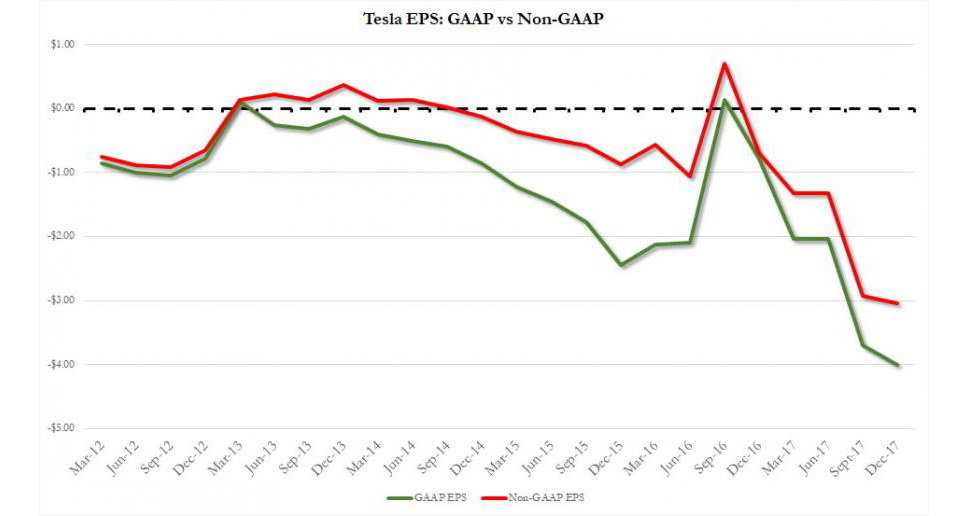
Доходность компании на акцию
В деньгах это, соответственно, 513 и 675 млн долларов. Особо интересен факт, что это очередной (и уверен) не последний рекорд по величине квартальных убытков.
Нужно учитывать, что Тесла записала себе в плюс 180 миллионов продаж ZEV кредитов. Это форма зеленого «налога», который Тесла крадет из кармана других автопроизводителей. Без этой суммы убыток был бы около 850 млн долларов.
Общий убыток за год — 2,24 млрд долларов, что значительно больше, чем убыток в 772 млн долларов в 2016 году.
Во-вторых, Тесла по-прежнему располагает большим объемом наличных средств. Остатки кэша на конец четвертого квартала — 3,4 млрд долларов. И, кстати, кэш уменьшился всего примерно на 270 млн за квартал. Это произошло за счет некоторых разовых операций, таких как сбор дополнительных депозитов, распродажа складских остатков, задержка платежей поставщикам. Так как в следующем квартале такое повторить не удастся, то, по всей видимости, сжигание кэша произойдет с темпом на 300-500 млн выше суммы квартальных убытков;
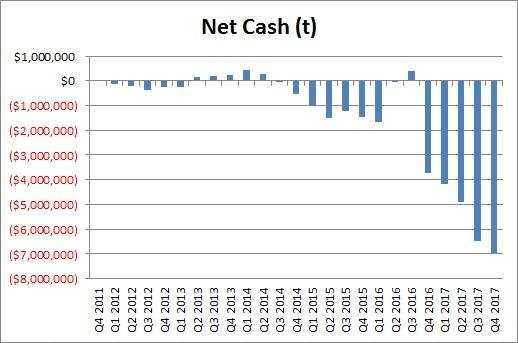
Суммарная накопленная величина кэш-потока компании
В-третьих, общая сумма долгосрочных долгов на конец года достигла 9,5 млрд долларов. Тут нужно учитывать, что Маск уже несколько раз «возвращал» деньги заимодавцам путем конвертации их займов в акции. Эти деньги уже учитываются не в долгах, а в «капитале» компании.
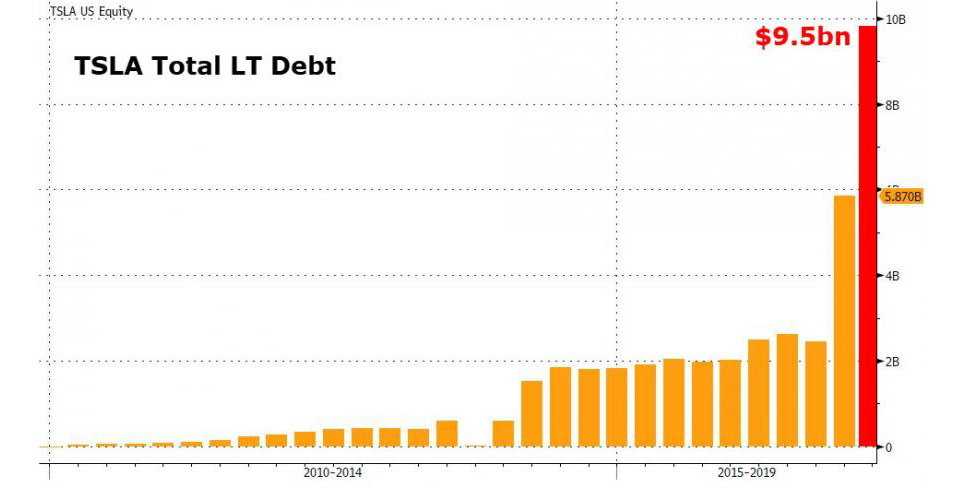
Накопленная задолженность компании
Кроме этого, сумма краткосрочных долгов (включая депозиты) составляет около 7,5 млрд долларов.
В-четвертых, депозиты покупателей достигли 853 млн долларов, увеличившись всего на 198 млн долларов. Это очень мало, так как только депозиты от «фаундейш-серии» нового родстера могли бы принести дополнительно 250 млн долларов, а ведь есть еще и депозиты на грузовик.
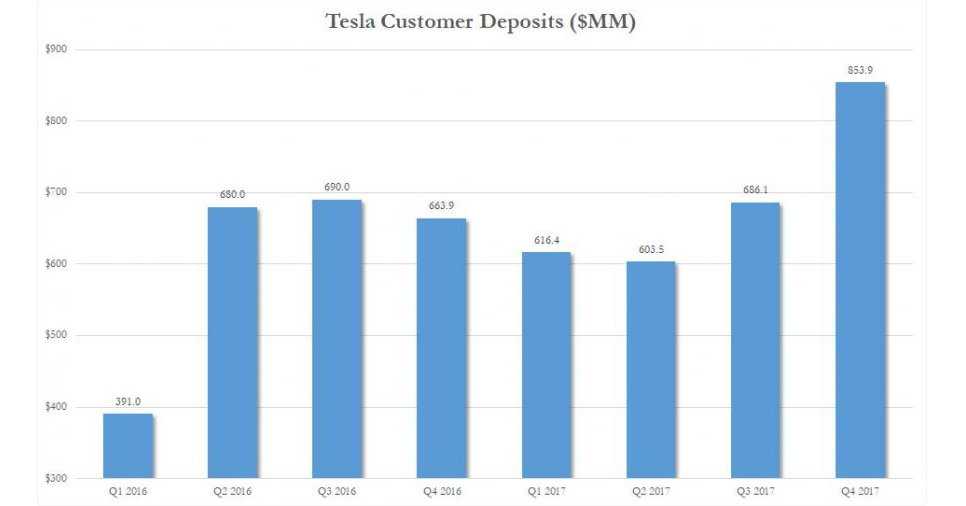
Депозиты компании
В-пятых, Маск сообщил, что совокупные продажи моделей S и X в 2018 году составят не более 100 000 штук, то есть меньше, чем в 2017 году. Причина: нехватка батареек старого форм-фактора.
Компания, несмотря на рост выручки, показывает все большую и большую убыточность. Зная об обманчивости такого показателя, как тесловская маржинальная прибыль, это не должно удивлять. При минимальной реальной прибыльности и максимальных иных расходах убытки компании могут только возрастать.
На пресс-конференции, прошедшей в день выпуска отчетности, Илон Маск рассказывал о чем угодно, но только не о реальных темпах производства. Причем он ушел от ответа даже на прямой вопрос об этом, заданный ему представителем Дойче банка.
По мере того как шел к завершению второй квартал, данные для Маска и Теслы выходили все более и более неприятные. В мейнстрим-средствах массовой дезинформации широко разнесли историю о том, что проблемы со сборкой связаны с некачественными комплектующими, которые они производят, 40% комплектующих приходится отсортировывать и переделывать. Продажи старых моделей, несмотря на сильные результаты конца марта, не достигнут результатов четвертого квартала.
Tesla
| P/E* | P/E/G | P/B | TEV/EBITDA |
| 1114 | 4,8 | 30,8 | 164,8 |
* Здесь и далее — данные на 27 апреля 2021 года.
По мнению многих аналитиков, одна из самых переоценённых крупных компаний. Первую годовую прибыль за свою 17-летнюю историю компания получила только в 2020 году: она составила $721 млн. При этом почти $1,6 млрд Tesla выручила не от продажи своей продукции, а от так называемых ZEV-кредитов. Иными словами, если бы не эти кредиты, то компания была бы убыточна.
В 2020 году Tesla продала около 500 тыс. электромобилей, а её капитализация, по данным на конец февраля 2021 года, составляла $648 млрд. Для сравнения, General Motors (GM) продала в 2020 году 2,5 млн автомобилей, Ford — 2 млн, а их стоимость — $74 млрд и $46,5 млрд соответственно.
Высокая оценка Tesla, очевидно, связана с перспективностью рынка электромобилей: по оценкам Wood Mackenzie, из-за более строгого экологического регулирования во многих странах к 2040 году в мире ежегодно будет продаваться 38 млн электромобилей и гибридных авто по сравнению с 2,2 млн в 2019 году.
Tesla расширяет производство и планирует в 2021 году продать 750 тыс. электромобилей. На планы компании по увеличению производства в будущем может повлиять возрастающая конкуренция: тот же GM недавно объявил об увеличениях инвестиций в разработку новых моделей электромобилей.
Challenges and Limitations of ZEV Adoption
Range Anxiety
One of the significant challenges of ZEVs is the limited range of travel on a single charge. This range could cause «range anxiety» for drivers who worry about running out of power before reaching their destination. However, advances in battery technology are improving the range and reliability of ZEVs, reducing this limitation over time.
Charging Infrastructure
The limited availability and accessibility of charging stations for electric cars create a significant barrier to adoption. However, many public and private initiatives are expanding charging infrastructure to meet growing demands. In addition, setting up hydrogen fuel stations for Fuel Cell Electric Vehicles is another infrastructure challenge that needs to be addressed.
Vehicle Cost and Availability
The cost of manufacturing ZEVs is still higher than traditional cars, and this reflects in their purchase prices, making them more of a luxury item. Another challenge is the limited availability of models, particularly for Fuel Cell Electric Vehicles, which are still in the development stage. However, the demand and increased competitiveness of the industry are expected to result in affordable and more accessible ZEVs in the future.
Types of vehicles eligible for credits
Vehicles eligible for credits include light-duty motor vehicles (passenger vehicles) that can travel on public roads, excluding motorcycles and mopeds. These vehicles are the following:
- fully electric vehicles, including those that run on a hydrogen fuel cell;
- vehicles equipped with a hydrogen-powered combustion engine;
- plug-in hybrid electric vehicles;
- any other vehicle powered exclusively by another means of propulsion that emits no pollutants or that is powered in conjunction with such a means of propulsion.
Vehicles eligible for credits must be new or, under certain conditions, be reconditioned by the manufacturer and registered in Québec for the first time.
Consult the
List of new or reconditioned motor vehicles eligible for credits under the Zero-Emission Vehicle (ZEV) standard
Первая жертва
Что самое неприятное — потребитель выбирает «теслы» вообще не за их ресурс. Сегодня не существует бензиновых машин с таким же сочетанием динамики и размера салона, как у Tesla Model 3. И сомнительно, что они вообще возможны: электромоторы компактнее, поэтому электромобиль имеет больше места, а короткий капот позволяет увеличить и длину салона. В теории ДВС-мобиль может иметь те же размеры, но тогда его придётся делать длиннее и дороже либо «ужимать» двигатель. Он может иметь лучшую динамику, но для этого ему надо иметь двигатель суперкара и цену суперкара. Всё это означает, что Daimler, BMW, Audi и Lexus должны сильно пострадать от американского новичка.
Владельцы электрокаров в РК могут получить преференции на дорогах и налоговые льготы
Именно это и происходит: в 2017 Model S обогнала Mercedes S-class, BMW 7-й серии и Аudi A8 в своей ценовой категории в Европе. Причём если у Model S европейские продажи за прошлый год выросли на 30%, то у BMW 7-й серии — упали на 13%. Tesla пожирает европейские марки заживо на их собственном рынке, а в Штатах процесс идет ещё быстрее. В 2018 Мodel S там опять показала рост продаж, в то время как продажи Cadillac XTS просели на 27%, Mercedes S-class — на 16%. Само собой, ценовых одноклассников Model 3 обошла куда сильнее, чем бюджетную Toyota Corolla. Tesla пока и на домашнем рынке не может удовлетворить спрос даже на самые дорогие модификации своей новой машины. Поэтому в Европу и КНР она пойдёт только в следующем году, тогда же и начнёт продажи базовой версии Model 3.
Are Regulatory Credits Sustainable
Tesla’s sales from regulatory credits totaled US$1.8 billion, US$1.5 billion, and US$1.6 billion for the years ended December 2022, 2021, and 2020, respectively.
That’s quite a lot of money from a “product” with zero production cost.
The good news for Tesla’s investors is that the revenue from sales of regulatory credits would most likely be sustainable in the foreseeable future as long as the production of fossil-fueled vehicles persists.
Remember that Tesla’s electric vehicle market share totaled less than 5% in most regions, as shown in the following snapshot.
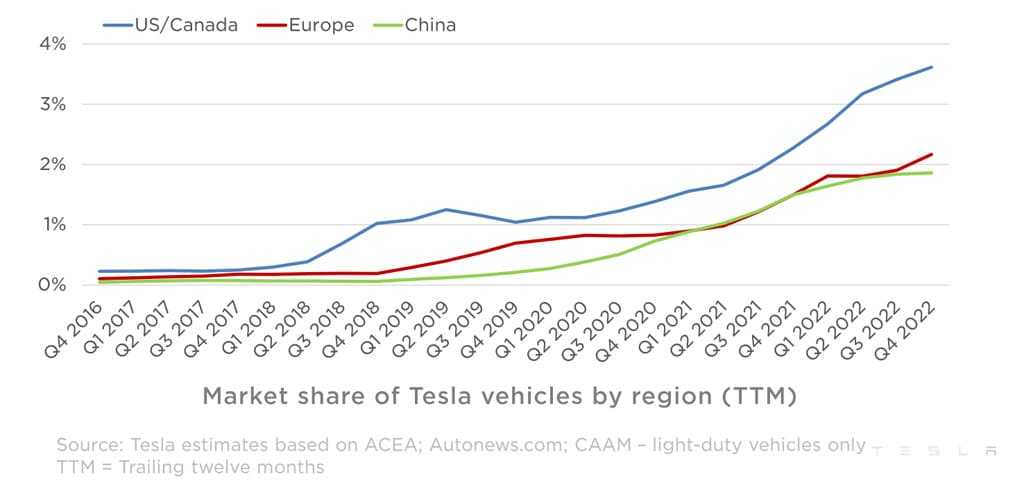
Tesla market share by region. Source: Tesla 4Q 2022 Update Letter
(click image to expand)
For this reason, Tesla’s sales of regulatory credits will be there and even surge when Tesla gains a more significant share of the automotive market.
In fact, Tesla’s regulatory credit sales have increased by an average of 36% year over year since 2013, according to the results in the plots below.
Read Tesla Automotive Leasing Sales Top US$1 Billion
Tesla can live without this extra income
Tesla is still in the early innings of its grand plan for fully-autonomous vehicles. It also has the ability to keep raising more capital through the sale of its high-flying stock.
Shareholders will also note that Elon Musk said that its autonomous software could be valued as much as US$100,000 per vehicle. With a growing base of Tesla vehicles, which are fitted with autonomous vehicle hardware, Tesla has a ready base of customers to up-sell a much higher margin software product.
In the meantime, the sale of ZEV credits can continue to be a source of cash for the next few years as the company bridges for the next phase of its business. Hopefully for shareholders, by the time the sale of ZEV credits dry up, Tesla’s other businesses will exhibit greater profitability and higher margins to keep the company’s profits and cash flow streaming in.
Want to know what stocks we like for our portfolio? See for yourself now. Simply CLICK HERE to scoop up a FREE copy of our special report. As a bonus, we also highlight 6 blue chips stocks trading at a 10-year low. But you will want to hurry – this free report is available for a brief time only.
Click here to like and follow us on Facebook, here for our Instagram group and here for our Telegram group.
Note: An earlier version of this article was published at The Good Investors, a personal blog run by our friends.
Disclosure: Jeremy Chia does not own shares in any of the companies mentioned.
Regulatory Credits Revenue Per Car Delivered
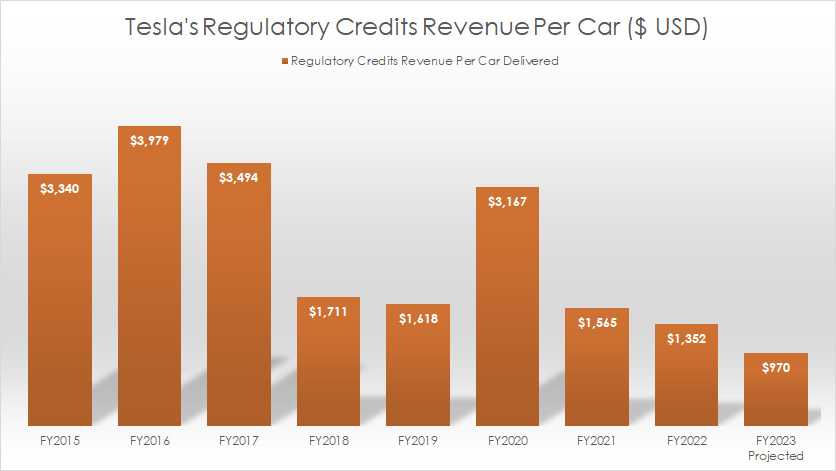
Tesla-regulatory-credits-revenue-per-vehicle-sold
(click image to expand)
* Tesla’s fiscal year begins on Jan 1 and ends on Dec 31.
From a per-vehicle perspective, Tesla earned US$1,352 in regulatory credits revenue per car sold in fiscal 2022, a decline of 14% over 2021 and more than 50% over 2020.
This figure has significantly declined since 2015, from US$3,340 per vehicle delivered in 2015 to US$1,352 per vehicle delivered as of 2022.
By the end of fiscal 2023, if Tesla were to deliver 2 million vehicles and earn US$1.9 billion in regulatory credits revenue, the per car revenue will come to a much lower figure, only at US$970.
The continuous decline in regulatory credits revenue per car suggests that Tesla will earns less carbon credits revenue per vehicle sold in the future.
Read 3D Systems Profit Margin Vs Stratasys
What does zero emissions mean?
Zero emission refers to an engine, motor, process, or other energy source, that emits no waste products that pollute the environment or disrupt the climate.
Is Zero emissions possible?
Innovation has an important role in the net zero initiative. So far, despite years of effort, it has not proven possible to deploy two large-scale zero carbon energy technologies: commercial nuclear power and carbon capture utilization and storage (CCUS).
What types of cars qualify as a zero emission vehicle?
Types of Zero Emission Vehicles:
- BEVs: Battery Electric Vehicles, which run exclusively on batteries.
- PHEVs: Plug-in Hybrid Electric Vehicles, which have a limited electric range and a range-extending gasoline engine.
- FCEVs: Hydrogen Fuel Cell Electric Vehicles, which are powered by electricity stored in hydrogen fuel.
Are Tesla’s zero emission?
Tesla manufactures the Model S, the first zero-emission, zero-gas, full-size electric vehicle on the market. In addition, Tesla has produced battery packs, electric motors, and other powertrain components that will power all-electric, plug-in vehicles—not only Tesla’s, but also those of other vehicle manufacturers.
Is Tesla Model 3 a zero emission vehicle?
Tesla believes the faster the world stops relying on fossil fuels and moves towards a zero-emission future, the better. Completing CEO Elon Musk’s “Secret Master Plan,” in 2016, Tesla introduced Model 3, a low-priced, high-volume electric vehicle that began production in 2017.
Legislation
ZEV Act and regulations
The Act to increase the number of zero-emission motor vehicles in Québec in order to reduce greenhouse gas and other pollutant emissions was unanimously adopted by the National Assembly on October 26, 2016.
It came into force in January 2018, at the same time as its attendant regulations:
-
Act to increase the number of zero-emission motor vehicles in Québec in order to reduce greenhouse gas and other pollutant emissions
-
Regulation respecting the application of the Act to increase the number of zero-emission motor vehicles in Québec in order to reduce greenhouse gas and other pollutant emissions
-
Regulation respecting the limit on the number of credits that may be used by a motor vehicle manufacturer and the confidentiality of some information
These regulations apply to model years 2018–2024.
The regulations were revised in 2023 to spur the automotive industry to improve the supply of electric vehicles in Québec. The majority of the amendments to these regulations affect vehicles from model year 2025 and subsequent years:
- Regulation to amend the Regulation respecting the application of the Act to increase the number of zero-emission motor vehicles in Québec in order to reduce greenhouse gas and other pollutant emissions (PDF, 308 KB)
- Regulation to amend the Regulation respecting the limit on the number of credits that may be used by a motor vehicle manufacturer and the confidentiality of some information (PDF, 314 KB)
The
Regulatory
Impact
Analysis(French,
PDF,
1.4 MB)
is also available.
Useful links
-
ZEV Standard — 2018-2020 Implementation Report (May 20, 2021, PDF, 4.3 MB)
- List of new or reconditioned motor vehicles eligible for credits under the Zero-Emission Vehicle (ZEV) standard
- Assessment of the results for the 2019-2021 compliance period (May 3, 2023 — PDF, 820 KB)
- Report on the Results of the First Compliance Period (April 15, 2020 — PDF, 8,2 MB)
- (manque traduction des titres) Credit Register Balance Sheet on September 1, 2021 (Model Year 2020) (February 14, 2022 — French, PDF, 640 KB)
- (manque traduction des titres) Credit Register Balance Sheet on September 1, 2020 (Model Year 2019) (February 16, 2021 — French, PDF, 500 KB)
- The ZEV standard in a nutshell — explanatory leaflet (
PDF, 3 MB) - Québec leads the way with its zero-emission vehicle standard — Article published on The Climate Group blog (February 16, 2018)
Regulatory Credits Revenue By Year
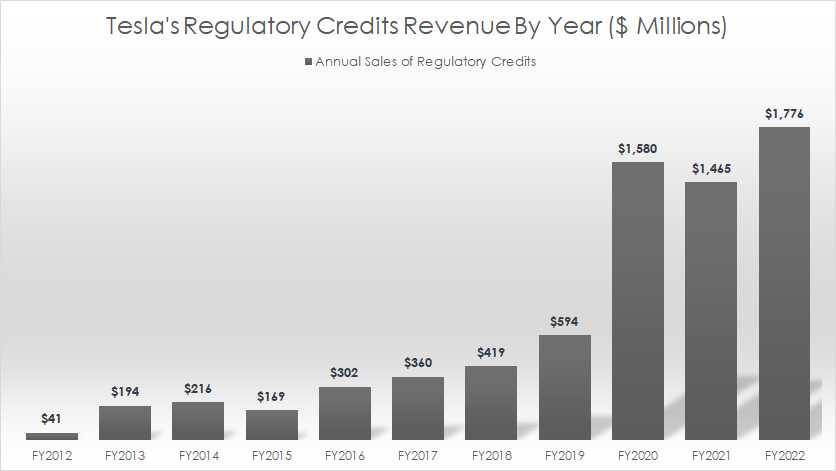
Tesla’s regulatory credits revenue by year
(click image to expand)
* Tesla’s fiscal year begins on Jan 1 and ends on Dec 31.
According to the chart above, Tesla’s sales of regulatory credits have significantly risen since fiscal 2012, reaching US$1.78 billion as of fiscal 2022, up 21% over 2021 or 13% over 2020.
As seen in prior discussions, Tesla’s sales of regulatory credits contribute directly to the automotive revenue.
As a result, Tesla’s automotive gross margin has benefited immensely from the sale of regulatory credits.
You will see in the following discussion that Tesla’s regulatory credits revenue helps to boost margins and profitability.
Read Tesla Energy Gross Margin Is On The Rise
Q1 Доходы не дотягивают, даже с неожиданным повышением
Резкий рост доходности иллюстрирует падение доверия Teslas как заемщика, поскольку доверие на улице падает до минимума. Непрерывная борьба высокопоставленного генерального директора Элона Маск с SEC мало что сделала для того, чтобы скрасить настроения вокруг некогда раскаленной акции. Акции Tesla резко упали после того, как на прошлой неделе они потеряли прибыль и производственные показатели Model 3, когда за квартал объявили убыток в размере 700 миллионов долларов. Поставки упали на 31% по сравнению с предыдущим кварталом, в то время как Маск в значительной степени проигнорировал вопросы, касающиеся спроса, и оставался непоколебимым в своих прогнозах на предстоящий год.
В дополнение к разочарованию более значительными, чем ожидалось, потерями в последнем квартале, последние 10 кварталов Тесла предполагают, что его мрачные доходы могли быть еще хуже, если бы они не были раздуты большим «всплеском» кредитов, не относящихся к ZEV, по словам аналитика Бернштейна Тони Сакконаги и других наблюдателей рынка.
В отличие от кредитов ZEV, которые являются кредитами на выбросы, используемыми Калифорнией и девятью другими штатами, кредиты, не относящиеся к ZEV, являются другими кредитами на выбросы, которые Tesla может продать компаниям, производящим слишком много автомобилей с выбросами. Сакконаги, один из давних быков Теслы, отметил, что увеличение, возможно, произошло из-за сделки с Fiat Chrysler, хотя причина менее важна, чем материальное воздействие. Как сообщило Business Insider, без Tesla в размере 216 миллионов долларов США квартальная потеря Tesla составила бы около 900 миллионов долларов. Валовая прибыль на Tesla Model 3, первом массовом рынке компании, составила бы 15% без учета всех кредитов, по сравнению с 20%, о которых сообщалось.
«Тот факт, что Tesla не сообщала и не обсуждала влияние кредитов, не относящихся к ZEV, на валовую маржу автомобилей на прогноз прибыли на прошлой неделе, вероятно, вызовет новые опасения у инвесторов», — сказал аналитик Bernstein.
Несмотря на более оптимистичные комментарии Сакконаги, он по-прежнему ожидает, что акции Tesla вырастут почти на 40% в течение 12 месяцев с текущих уровней и достигнут целевой цены в 325 долларов. Он поддерживает рейтинг рынка по акциям пионера рынка электромобилей.
«С одной стороны, нынешние настроения кажутся нам, возможно, чрезмерно негативными, поскольку акции сейчас находятся ниже своего исторического 2-летнего торгового диапазона», — пишет Сакконаги. «С другой стороны, нам все еще необходимо добиться убежденности в нормализованной валовой и операционной марже — относительно эластичности спроса — чтобы стать более конструктивным в долгосрочной перспективе. Имея это в виду, эти последние данные о кредитах, отличных от ZEV, постепенно отрезвляют ».
Без единого шанса
Следует понимать, что происходящий жёсткий передел рынка по сути отсекает от него всех, кто не располагает доступом к большим и долгосрочным кредитам. И это очень плохо.
Анатолий Балушкин: Добавленная стоимость нового автомобиля должна оставаться в Казахстане
«Автоваз» за последние пять лет инвестировал в производство 90 млрд рублей. Tesla каждый год инвестирует больше $2 млрд. В России вообще есть только одно промышленное предприятие, которое хотя бы приблизилось к такой цифре, — «Уралвагонзавод». Понятно, что государство костьми ляжет, но обеспечит инвестиции, поскольку отстать в технологическом уровне танков мы себе позволить не можем. Но не менее очевидно и другое: государство за весь постсоветский период не инвестировало в автопром средства, сравнимые с инвестициями в танковый завод. И оно никогда не будет этого делать. Сами же владельцы российских автозаводов этого не станут делать тем более. Как пишут в прессе, «невозможно высокая внутренняя цена денег, отсутствие комплексной, страновой перспективы развития хозяйства приводят к тому, что компании предпочитают стратегию минимальных вложений при супермаржинальности». Проще говоря, их волнует только одно: как бы вложиться поменьше, а прибыль получить побольше.
На таких принципах конкурировать в высокотехнологичной области невозможно. Чтобы хотя бы пытаться выжить в условиях электромобильного нашествия, надо инвестировать, как Volkswagen AG. Эта немецкая компания планирует выжить на одном рынке с Tesla и поэтому намерена вкладывать в электромобили по $5 млрд в год. Вся российская крупная обрабатывающая промышленность, вместе взятая, инвестирует в производство заметно меньше.
Нельзя сказать, что таких денег в нашей стране не было в принципе. Например, «Газпром» инвестирует и $20 млрд в год. Но то, что возможно для нефтегазового сектора, нереально для нашей обрабатывающей промышленности. Там просто нет таких денег. А если она будет инвестировать в кредит, то при имеющихся процентах тот же «Автоваз» будет гуманнее сразу закрыть, чем мучить его, безнадёжно пытаясь выплатить сверхдорогие займы.













![Каков средний доход владельца tesla? [решено]](http://susaninskaya.ru/wp-content/uploads/6/0/4/604a2a54dee921c2d2db20f7bc8ae0f4.jpeg)













